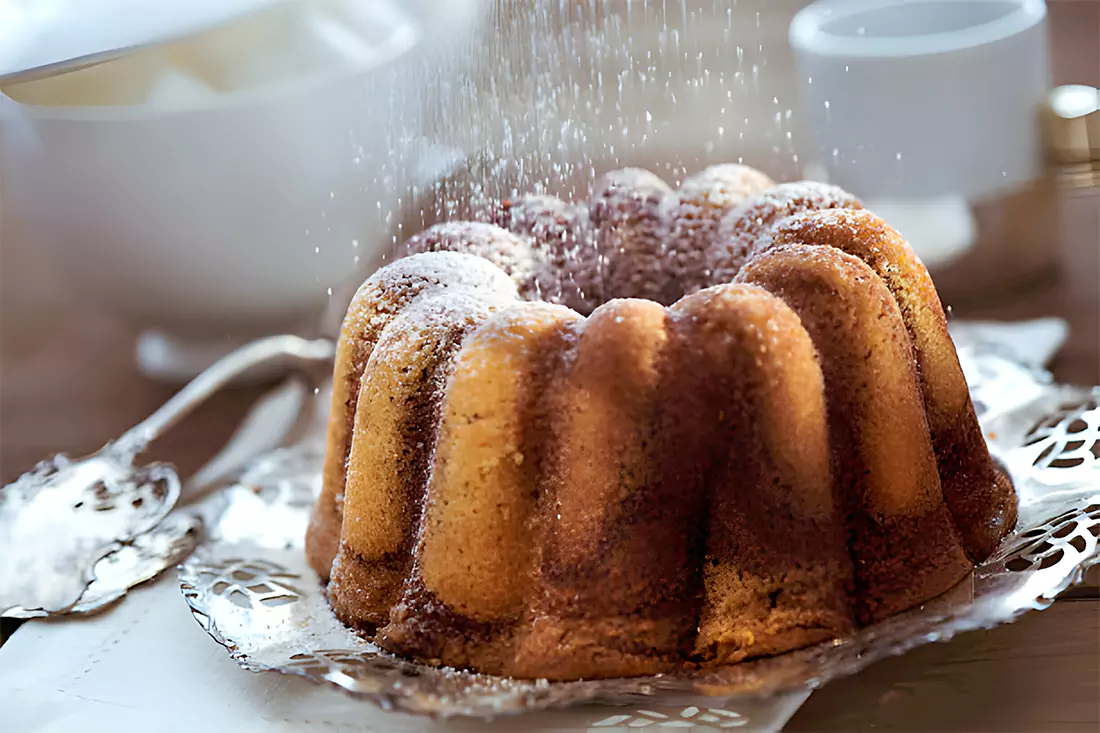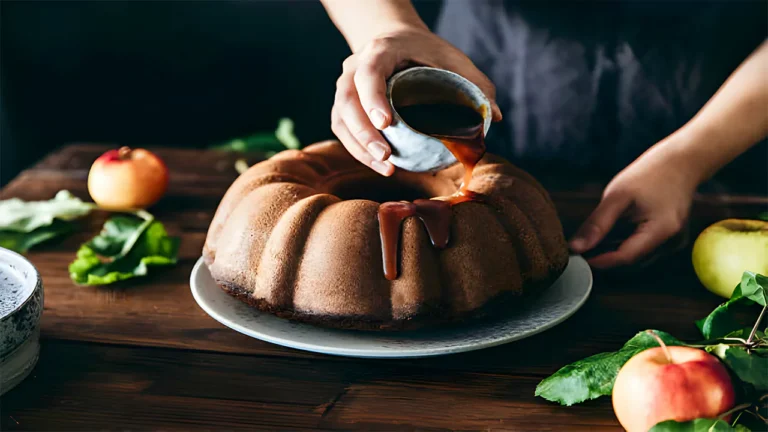Understanding Bundt Cakes
Start by introducing the topic. For example, “In this article, we’ll explore the common reasons behind Bundt Cake Dryness and how to prevent it
The Unique Nature of Bundt Cakes
Ah, the Bundt cake! A true icon in the world of baking. Its distinctive shape, with that central hole, isn’t just for show. It ensures even cooking, a must for such dense delights. But here’s the rub: that same density can lead to dryness if not tackled with care.differences between Bundt cakes and regular cakes
Popularity and Variations
From humble beginnings, the Bundt cake has risen to fame, thanks in part to its versatility. Whether it’s a classic lemon drizzle or a chocolate lover’s dream, there’s a Bundt for every taste. But with great variety comes great responsibility. Each flavor and variation demands its own unique approach to avoid the pitfall of dryness.
Culprits Behind Dry Bundt Cakes
Ingredient Proportions and Quality
First things first, let’s talk ingredients. The key to a moist Bundt cake lies in the balance of its components. Too much flour or sugar can spell disaster, leading to a cake that’s dry and crumbly. It’s not just about quantity, though. The quality of ingredients plays a pivotal role too. Opt for fresh, high-quality items to give your cake the best shot at moist perfection.
The Role of Flour Types
Flour isn’t just flour. The type you use can make or break your Bundt cake. Cake flour, with its fine texture and lower protein content, is a baker’s secret weapon for a tender, moist cake. Substituting it with all-purpose flour? Tread carefully. The wrong flour can lead to a dense and dry outcome.
Fat Content: Butter vs. Oil
Butter or oil? That is the question. While butter brings flavor, oil is the champion of moisture. A cake made with oil tends to stay moist longer than its butter-based counterpart. If you’re set on using butter, consider a mix of both to strike a balance between taste and texture.
Oven Temperature and Baking Time
The oven can be your ally or your adversary. An oven that’s too hot will dry out your cake, while one that’s not hot enough can lead to uneven baking. Always preheat your oven and consider using an oven thermometer for accuracy. Remember, even a few extra minutes in the oven can turn your Bundt cake from moist to dry.
Mastering the Art of Moist Bundt Cakes
Proper Measuring Techniques
Precision is key in baking. A little too much flour or a tad less liquid can lead to a dry cake. For accuracy, weigh your ingredients rather than relying on volume measurements. This ensures consistency and helps avoid the common pitfall of adding too much flour, which is often the culprit behind dryness.
Mixing Methods to Avoid Overmixing
Mixing is an art. Overmixing the batter develops the gluten too much, leading to a tough and dry cake. Gentle and just enough – that’s the mantra. Mix until the ingredients are just combined to keep the cake tender and moist.
Choosing the Right Bakeware
Not all bakeware is created equal, especially when it comes to Bundt cakes. The material of your pan can affect how the cake bakes. Metal pans, particularly dark ones, conduct heat more efficiently than glass or ceramic. This can lead to quicker baking times, so adjust accordingly to prevent overbaking and drying out your cake.
Oven Calibration for Consistent Heat
An inconsistent oven can be a baker’s nightmare. Regularly calibrating your oven ensures it heats to the correct temperature, crucial for baking a perfect Bundt cake. An oven that runs hot or cold can result in a cake that’s dry on the outside and undercooked on the inside.
Choosing and Tweaking Bundt Cake Recipes
Selecting the Right Recipe
The foundation of a great Bundt cake starts with the right recipe. Not all recipes are created equal, and some are more prone to dryness than others. Look for recipes that have been tested and reviewed positively for moisture. Pay attention to the balance of wet to dry ingredients; a good recipe should have enough liquids to balance the flour and sugar.
Adapting Recipes for Moisture
Sometimes, you might want to tweak a classic recipe for added moisture. Consider adding ingredients like sour cream, yogurt, or buttermilk. These not only add richness but also tenderize the cake, helping to keep it moist. You can also experiment with adding fruit purees, like applesauce or mashed bananas, which can enhance moisture without altering the cake’s structure significantly.
Ingredient Substitutions
Substitutions can be a game-changer in preventing dryness. If a recipe calls for all-purpose flour, consider swapping some of it with cake flour for a lighter, moister texture. Similarly, replacing some butter with oil can help maintain moisture over several days. However, be cautious with substitutions; they should complement the recipe’s original balance.Gingerbread Bundt cake recipe

Keeping Your Bundt Cake Fresh and Moist
Short-term vs. Long-term Storage
The way you store your Bundt cake can greatly impact its moisture content. For short-term storage, keeping the cake at room temperature under a cake dome or wrapped in plastic wrap is ideal. This method helps retain moisture without altering the cake’s texture. For longer storage, freezing is your best bet. Wrap the cake tightly in plastic wrap and then in foil before freezing to preserve its freshness and moisture.
Refrigeration: Pros and Cons
Refrigeration can be a double-edged sword for Bundt cakes. While it’s necessary for cakes with perishable fillings or icings, refrigerating a cake can also dry it out. If you must refrigerate your cake, wrap it tightly to prevent it from absorbing odors and losing moisture. Remember to bring it to room temperature before serving for the best flavor and texture.
Freezing Techniques
Freezing is an excellent way to extend the life of your Bundt cake without sacrificing moisture. Cool the cake completely before wrapping it in plastic wrap, followed by a layer of aluminum foil. When you’re ready to enjoy it, thaw the cake in the refrigerator overnight and then at room temperature for a few hours to ensure it regains its original texture and moisture.
Ultimate Guide to Moist Bundt Cakes
Salvaging a Dry Bundt Cake
Identifying Dryness Early
The first step in rescuing a dry Bundt cake is recognizing the signs early. If the cake feels firm and lacks the springiness typical of a moist cake, it’s time to take action. The sooner you address the dryness, the better your chances of reviving your cake.
Quick Fixes for Dry Cakes
One of the simplest ways to add moisture back into a dry cake is using a syrup soak. A mixture of sugar and water, often flavored with extracts or liqueurs, can be gently brushed over the cake, infusing it with moisture and flavor. This method works wonders, especially for cakes that are only slightly dry.
Creative Ways to Repurpose Dry Cake
If your Bundt cake is too dry to salvage as is, consider repurposing it. Dry cake makes excellent trifle layers, cake pops, or even a base for a bread pudding. These creative solutions not only save your cake from going to waste but also transform it into a new and delicious dessert.

Frequently Asked Questions About Bundt Cakes
Common Queries and Concerns
Bundt cake enthusiasts often have a host of questions, from ingredient choices to baking techniques. This section addresses those common queries, providing clarity and confidence to both novice and experienced bakers.
Expert Answers and Tips
-
Why is my Bundt cake dry?
- Dryness can result from various factors, including overbaking, incorrect measurements, or the wrong type of flour. Ensuring accurate measurements and adhering to baking times is crucial.
-
Can I substitute oil for butter in a Bundt cake?
- Yes, oil can be used in place of butter to enhance moisture. However, keep in mind that this may alter the flavor and texture slightly.
-
How do I prevent my Bundt cake from sticking to the pan?
- Properly greasing and flouring your Bundt pan is key. Some bakers also swear by using a baking spray that contains flour for a more reliable non-stick surface.
-
Is it better to use cake flour or all-purpose flour?
- Cake flour is preferred for a lighter, more tender Bundt cake. However, all-purpose flour can be used, especially if the recipe specifically calls for it.
-
How long should I cool my Bundt cake before inverting it?
- It’s generally recommended to cool the cake in the pan for about 10 minutes before inverting. This allows the cake to set and reduces the risk of breaking.
For more detailed insights on baking techniques, visit King Arthur Baking Company’s website
Perfecting Your Bundt Cake Baking Skills
Summary of Key Takeaways
In our journey through the world of Bundt cakes, we’ve covered a lot of ground. From selecting the right ingredients and understanding the role of different flours to mastering the art of baking and storage, each step is crucial in ensuring a moist and delicious Bundt cake. Remember, the devil is in the details – accurate measuring, careful mixing, and baking at the right temperature are your keys to success.
Encouragement for Continued Learning and Experimentation
Baking is both a science and an art, and there’s always room for experimentation and growth. Don’t be afraid to try new recipes, tweak existing ones, and learn from each baking experience. Each Bundt cake you bake is an opportunity to refine your skills and add your own creative touch.
